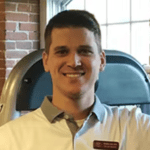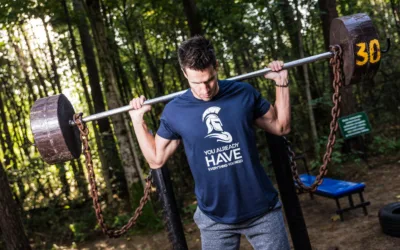Work Now, Golf Later: Add Years to Your Golf Career with Strength Training

Dr. Matthew Styf is a clinical orthopedic specialist and CSCS out of Massachusetts. He’s also a certified TPI Medical L2 professional through the Titleist Performance Institute. He enjoys working with athletes of all ages, but takes special interest in golfers. Read on to learn more about his ideas for strength work to improve your swing, stamina, and more.


Strength Training Exercises for Golfers — Get to Work!
I’m not talking about “work” as in your job, I’m talking about putting in the physical work in the gym. Going to the gym, working out, and lifting weights are very new and foreign topics to a large group of golfers. But what if I told you that gaining strength and improving your fitness will help with your golfing longevity?
The idea of taking time off the course to get better is hard for many golfers to wrap their minds around. Adding in strength training doesn’t have to be a large time commitment, but it does have to be enough. For example, a seasonal workout plan would be 3-4 days of training a week from November to April, decreasing to 1-3 days as the weather warms up and you play more often.
If you don’t have a current workout plan or you continue to come up short on that New Year’s Resolution every year, maybe it’s time to ask yourself why.
If you’re not strength training after you turn 30, you’re missing out on some big benefits.
After the age of 30, you can lose up to 3-5% of your muscle mass per decade. This muscle loss combined with the violent movements of the golf swing causes golfers to lose distance, consistency, and play time due to pain.
So let’s do some math. By the age of 60, which is nearing retirement and when most people begin to golf more, you could lose up to 15% of the muscle you had at age 30 if you had not not been working on maintaining/gaining strength.
Golf Fitness for Injury Prevention
About 50% of amateur golfers (men and women) report back pain when they golf. So, what if the right workouts could replace the pain medication bottle in your golf bag? You could make room for your protein shake or snack food for the back 9.
Now, golfers don’t just injure their backs – they can also hurt their shoulders, knees, hips and elbows. It’s important for golfers to get at least one well-rounded, total body workout each week. But where do you start?
Golf specific workouts are 80-90% the same as a lot of other workouts for athletes. The 10-20% difference is more concentration on rotational power and rotational mobility.
You Work too Hard to Not See Progress
Find Your Perfect Training Plan
Options for Every Goal
Training plans from real coaches covering any goal, fitness level, and number of sessions per week.
The Best Coaches
Get coached by the best. Olympians, ex-NFL stars, Titan Games Winners, Sport Scientists and more.
Starting at $1/ day
With many options including a free 7 day trial, you can try out programming before you commit.
Beginner Golf Workouts: It’s All About the Glutes and Core
So you’re in the gym. Now what? Since the glutes are the king and the abs are the queen of the golf swing, let’s start there.
The list of exercises is exhaustive and can be overwhelming when looking on the internet. Start by learning the basic hip hinge movements. This will help you progress to exercises such as a Romanian deadlift or trap bar deadlift. Having strong hips and a mobile posterior chain will make a massive difference in your swing.
As for core, crunches, Russian twists, and sit ups may not be the best for you. If you are looking to golf for a long time, learning to control spinal movement and use it as an area to transmit force is more important and safer.
Exercises for core stability that work great for golfers are:
- Planks and side planks
- Pallof presses
- Weighted carries
In addition to the glutes and core, exercises that focus on rotation at the mid-back, hips, and shoulders are important as the primary rotators during the golf swing.


Level Up Your Training
With TrainHeroic’s immersive training app
TrainHeroic does everything you wish your old gym notebook could do.
Take the guesswork out of training with built-in exercise instruction and basic training programs. Compete against yourself and others. Track your performance and readiness. Smash your goals.


Golf Weight Training to Fit Your Lifestyle
Each of the full-body days has a warm up, power development component and 2-3 strength supersets or tri-sets. Each day also addresses upper body push, upper body pull, squat/lunge, a hip hinge variation and core strength.
Why do I program it like this? As someone who is employed, a homeowner, and a father of two kids under the age of six, I try to increase my workload without increasing my time in the gym.
I understand that life gets in the way and spending an hour or more in the gym isn’t realistic for everyone. By adding supersets and tri-sets, you can work your lower body and upper body at the same time while giving your other body parts a rest.
The idea is that you’re putting in the work three days a week so you can play golf or participate in life without feeling like you’re going to hurt yourself or miss out on other life events. It’s all about finding your minimal effective dose of strength training in order to enjoy life both on and off the golf course.
Want Training Tips, Exercise Guides & Knowledge Bombs Sent to Your Inbox?
Sign up for the FitNerd newsletter from TrainHeroic
Related articles
Slow Reps vs. Fast Reps
You’ve probably noticed that some people in the gym tend to perform their reps as fast as possible, whereas others take a slow and controlled approach. But which is better? Dr. Andy Galpin is a Professor of Kinesiology at the Center for Sport Performance at California...
How to Do Leg Extensions Without a Machine
Short shorts are the new stinger tanks. Rocking those big tree trunks with canyon deep cuts is so hot. Leg extensions are a bodybuilding staple—they isolate your quads, the front-facing muscle group of your thighs, by flexing (bending) and extending (straightening)...
Tried-and-True Methods to Fix Plantar Fasciitis
What is Plantar Fasciitis? If you’re new to running or returning to it after a break, you might have been blighted by plantar fasciitis, a fancy name for an annoyingly common foot problem. It’s when the band of tissue that connects your heel to your toes (the plantar...


Join the community
Sign up for the latest training news and updates from TrainHeroic


About TrainHeroic
Support
Made with love, sweat, protein isolate and hard work in Denver, CO
© 2021 TrainHeroic, Inc. All rights reserved.






